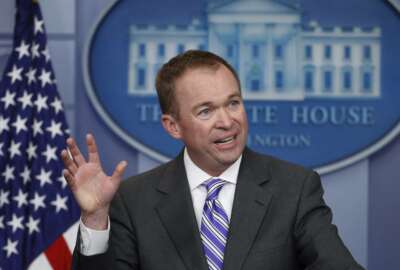
FY18 budget cuts could slice into civilian agency programs, personnel
The Trump administration's plan to reduce non-defense discretionary spending by 10 percent means civilian agencies will need to look at programs and personnel, not...
The White House’s announcement that the fiscal 2018 budget would boost Defense spending by $54 billion is a campaign promise kept, according to administration officials. But for small civilian agencies and some large departments, it means trimming fat could cut deep into the federal workforce.
The Office of Management and Budget Director Mick Mulvaney earlier this week said that the spending plan is a “true America-first” budget, and keeps President Donald Trump’s pledges to prioritize rebuilding the military and protect national borders.
Former federal finance officials said there is still time between agencies and OMB to negotiate, but with the messages being sent from the White House, some things are going to have to go.
“This is a time of transition, there are lots of things moving around,” said David Haun, a director in Grant Thornton’s global public sector branch. Haun led efforts at OMB during the creation of the Homeland Security Department. “I suspect there will be a negotiation between the agencies and OMB but the overall goals here seem pretty well-defined. If in fact $50 billion has to come out of non-defense discretionary then there’s going to be some ‘sausage making’ maybe to find a way to get that much of a cut, and at the same time put forth a realistic budget that could be enacted and actually implemented.”
Agencies received their topline and have a week or two to review recommendations from OMB on how it thinks each agency can hit their number — a process called passback. Rumors are already swirling that the administration could cut the State Department’s foreign aid and diplomacy by 37 percent, according to the Associated Press.
Haun said it’s the smaller, non-defense agencies that will likely feel deep cuts, Haun said. Even though DHS and the Justice Department are considered civilian agencies, the administration has made it clear that some areas like veterans services and law enforcement programs are safe from cuts.
“It may be that cuts to the other parts of the non-defense discretionary may be even deeper than 10 percent in order to protect those parts of the non-defense side that we think may be protected,” Haun said. “So 13, 14, 15 percent might not be out of line for an EPA or an Education [Department] or some of these other program areas that are not going to be protected.”
Robert Shea, a principal at Grant Thornton, and former associate director for administration and government performance for OMB, said the traditional approach to spending adjustments is a “haircut” across the board.
“It’s the least responsible way to do budgeting, but it’s the easiest way to do budgeting,” Shea said. “Agencies have at least some offsets in their back pocket. This is not the first time they’ve been through similar drills, so they’ve got a list of things they would put forward or have considered putting forward in the past that they can bring.”
Shea said the $80 billion to $90 billion spent annually on IT might be one place to start, but Danny Werfel, former controller at OMB under President Barack Obama, said that could have a long-term effect on an agency down the road, since modernization — when done correctly — helps with customer service, as well as reducing fraud, waste and errors.
Werfel said a catch-22 some agencies find themselves in is knowing an upfront investment could help reduce spending in the long term, but when faced with a directive to immediately shrink a budget, there’s not a lot of room — or in some eyes, a justification — for that investment.
Agencies do have some areas that are often the first to be put on the chopping block, like employee training and discretionary travel.
“Let’s say you had spots open, FTE spots that haven’t been filled, and you might say well, the first thing is we’re going to freeze training dollars and we’re going to create a higher bar if you’re going to do discretionary travel and we’re not going to hire these spots,” Werfel said. “That’s not all the time but sometimes [training and travel] can come up as some of the low-hanging fruit when trying to absorb a cut. I think some people rightfully lament the fact training is the first to go, because training is important. We want our workforce prepared in the best possible way do to our jobs.”
Haun said some other areas that agencies might try to cut are large state and local grants programs, but that might not get much traction, since congressional members are very supportive of these programs. This means that agencies that can’t trade off program cuts could find themselves looking toward payroll.
“If the agencies are heavily staffed with onboard federal employees and that’s a large part of their budget, and they’re going to have to reduce their staff beyond attrition, that’s where the real challenges are going to be, if they can’t trade off those cuts with program cuts. In an agency as well, if they saw this as a one-time cut, they would look for those kinds of one-time opportunities,” Haun said. “But if this is the new normal, that we’re going to reduce say, EPA by 10 percent, then agencies have to look at reducing staffing as a way to get down costs long term.”
But factoring in appeal time, severance pay and annual leave balances, some agencies might have to cut closer to 20 percent of their personnel spending just to break even with the directed 10 percent, Haun said.
Negotiations and passbacks
If things seem to be happening quickly, that’s because it’s a transition year. Haun said what’s happening now is not dissimilar from previous transitions. What’s normally a months-long process in the fall is being condensed into roughly two months, Haun said, as the administration is feeling the pressure to get a budget document out and over to Congress.
Obama also released a summary version of his first budget in late February 2009. He signed an omnibus spending bill March 11.
The continuing resolution that lawmakers passed last year expires Apr. 28. Congress must still agree on a funding solution for the remainder of fiscal 2017, and according to the congressional schedule, most lawmakers are on recess for two weeks in April.
The shortened time frame doesn’t mean the number crunching and negotiation between agencies and OMB doesn’t happen. Even before the passback, agencies and OMB are communicating about budget requests and targets to hit.
Werfel said agencies will look at their mission and activities and programs, and weigh where the cuts should come from. The agency will present a less painful version of the budget, “which is maybe not consistent with the overall guidance, but they at least want to sit down with OMB and show them that there’s maybe still ways to reduce spending but maybe not as steep and in a way that’s a little bit more palatable, balancing a variety of factors.”
The passback process should take until mid-March, which puts the administration on a schedule to get out the full budget by early May.
“This is not new. What may be new is the steepness of cut that hasn’t been contemplated previously, that requires a different level of review of activities that agencies have done in the recent past,” Werfel said.
Agencies also have room to appeal to OMB, Haun said. There’s a formal process, normally conducted by department heads or agency secretaries, who plead their case.
“In most cases the agency knows they’re not going to get everything they asked for,” Haun said, but a secretary can come back to OMB and present priorities or offer a trade for something of higher and lower priority for the agency that it is willing to negotiate on.
Time for budget reform?
Support and criticism for this budget thus far — $603 billion for Defense and $462 billion for non-Defense discretionary spending — has largely fallen along party lines, and federal employees unions have spoken out against the proposed cuts.
“Remember, the $54 billion cut proposed by the administration is not savings for the taxpayer: It simply shifts the money, dollar-for-dollar, to an increase in military spending,” said National Treasury Employees Union (NTEU) National President Tony Reardon. “These across-the-board cuts do not reduce the deficit and are so deep as to make government less efficient, not more.”
And while there’s partisan fighting over the numbers, some are using the proposed plan as a platform for consideration of budget process reform.
Non-defense discretionary spending has been “twisted and wrung dry for decades”, said Doug Criscitello, executive director of the Massachusetts Institute of Technology’s Center for Finance and Policy, and former CFO of the Department of Housing and Urban Development.
“At some point the U.S. government crossed the threshold from doing more with less to doing less with less,” Criscitello said in an email to Federal News Radio. “If this category is the only politically acceptable area for reductions, targeted program terminations including a more aggressive effort to reduce redundancies may be preferable to the across-the-board reductions we’ve typically seen in the past. Better to run some programs with sufficient funding than to operate all in an impaired budgetary state.”
Copyright © 2025 Federal News Network. All rights reserved. This website is not intended for users located within the European Economic Area.




